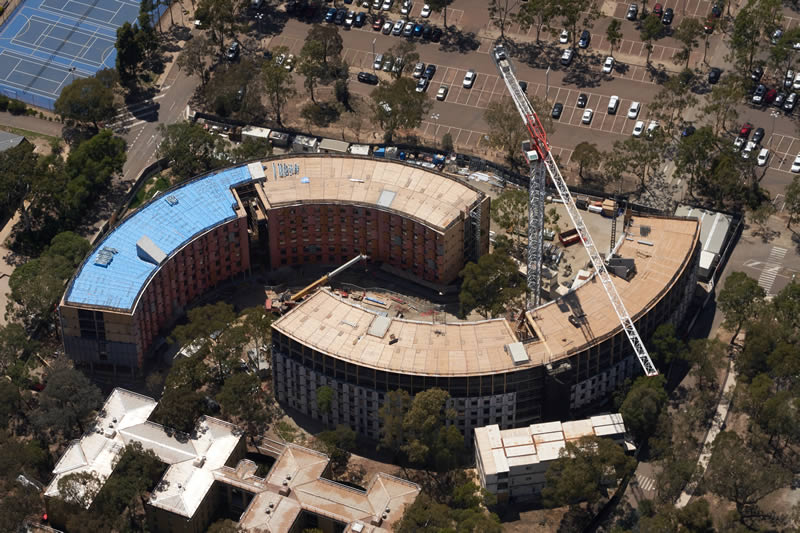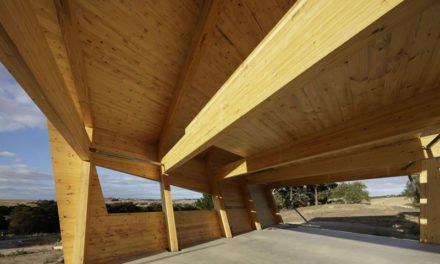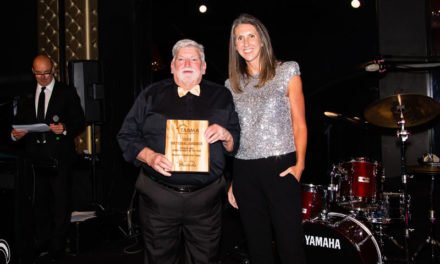As experts and exhibitors prepare for Timber Offsite Construction 2020, we preview some of the event’s highlights and look at how the new methodology is changing construction.
For over two decades, Kevin Ezard and his Frame Australia team have been promoting the use of timber products for use beyond residential housing in Australia at their annual events. This June’s Timber Offsite Construction 2020 comes with a theme of ‘Timber & Technology. The Zero Carbon Future’, and more than ever, it has its finger on the pulse of where construction is moving in this country and internationally.
Over the past five years, an industry-wide effort, combined with bold investment from some of the country’s best builders, has seen tall and mid-rise timber construction move from being a talking point to becoming a standard building method. The number of completed and under-construction builds has been steadily increasing, and with that has come an expansion in expertise in offsite methods for builders and fabricators, and a growth in local materials supply.
Couple this with the increasing public demand for a low-carbon future and it’s clear we’re sitting on what should be a rising tide that will lift many of the industry’s boats.
This year’s event brings together many of the people who have been at the forefront of this change and looks to encourage, inform and empower others – from designers to fabricators – to join them.
It’s happening now
Talking with builders, manufacturers and other industry voices for our TTN tall timber special in the January edition, one thing repeated from many sources was that although mid-rise and tall timber buildings still represent only a small percentage of completions, that percentage is now well established and will continue to grow. Moreover, mass timber products and offsite and panelised construction methods are now industry standard.
At the top end, this is readily apparent. Multiplex recently topped out its twin building development for La Trobe University’s $100 million student accommodation project at its Bundoora campus.
This project is the largest mass timber construction project currently underway in Victoria, with the entire development utilising a full cross-laminated timber (CLT) and glulam structure.
Multiplex regional managing director Graham Cottam made an announcement on the occasion: “We are passionate about sustainable design technologies, so we are thrilled to utilise mass timber and be the largest new development in Victoria doing so. Student accommodation combines our skills in delivering quality residential developments with our experience in working in busy, live education environments.”
The project is a showcase of the benefits of timber construction. The site is complex, in the middle of a busy university and designed to retain as many existing trees as possible. Using quick-to-erect mass timber and the rigorous scheduling that comes with prefabricated elements common in tall timber construction, Multiplex has minimised the time and disruption of the build at the same time as halving the carbon cost of the building itself, relative to a similar concrete structure.
At the lower-scale end, it’s harder to get a clear picture, but multiple fabricators who have long embraced new wood products such as LVL and glulam are also moving into some degree of offsite construction, with wall and floor panels (both in engineered wood product and traditional timber) now commonplace. Suppliers such as Timberlink are steadily increasing the amount of mass timber product on the market in full expectation of this trend to grow even faster in coming years.
Spreading the word
Two Frame Australia events ago, the biggest complaint was not enough people knowing how to work in the new methods, nor with some mass timber products.
Suppliers were some of the first to respond, with big names including Tilling Group, Hyne and Wesbeam providing engineering guidance and services to designers and reaching out to fabricators and builders to familiarise them with materials and design needs. It’s been a great start, but more is required industry wide.
Box Hill Institute is leading the way on the training side. They’ll be at Timber Offsite Construction 2020 promoting two new state qualifications in prefabricated building systems (timber) that have been developed and accredited under the Victorian Workforce Training Innovation Fund (WTIF):
- 22501VIC Course in Onsite Installation of Prefabricated Building Systems, and
- Delivery mode Diploma of Project Management for Prefabricated building systems (Timber)
These courses are designed to address emerging knowledge and skills gaps in project management and onsite installation. Both have been cleverly designed to take into account the needs of their audience, offering online and blended learning modes of delivery, where students can complete work online, and participate in masterclasses, practical workshops and tutorials.
They’re aimed at the existing workforce in order to build and expand contractor capability in early contractor involvement, transport and logistics, costing, codes and standards and WHS.
“The programs prepare the student with the required skills and knowledge so that advantages of prefabricated building can be achieved for both the client, design team and builder,” says Tony Watson, executive manager – business development (apprenticeships and traineeships) at Box Hill.
Each course covers project management and installation of a range of building solutions including mass timber construction, light weight timber, panelised and modular construction. Students of the course in onsite installation learn how to install CLT and other timber systems.
There has been significant industry involvement during the development and delivery stages, including Xlam Pty Ltd, Sinjen, Wood Solutions, Lendlease Designmake, Atelier Projects, Himmelzimmer, Carbonlite Design and Build, The Tilling Group, Rothoblaas, Standstruct and AMGC.
Watson points out that the prefabricated building market within the construction industry is expected to grow from 3% to 15% by 2025. This will generate around 20,000 new jobs and $30 billion of growth. Now is the time to put in place the basics we will need to accomplish this.
Exhibitor education
Hearing about Box Hill’s first intake last year was a fascinating learning experience over a break in the conference proceedings. One of the great joys of the event is the exhibition that takes place concurrently outside the speaker venues. Not only are the businesses on the floor sector leading in their innovation, they also represent decades-worth of expertise.
At the time of printing, 2020’s list of Current Partner Exhibitor Organisations was:
Australian Framing Automation This newly established company represents Modular Building Automation (MBA) from the UK and their timber framing machinery products in Australia and New Zealand.
Biesse Australia Famed for their woodworking machinery and CNC capability, the Italian firm will have their comprehensive range of technologies on show.
Big River Group Innovation in timber and floor building systems have led to this Australian firm’s success in both its product range and successful relationships with developments.
Bliss & Reels These prefab specialists make panelisation accessible as part of their supply of manufacturing machinery and automation from Australia, Sweden and Italy.
Box Hill Institute Pioneering new timber construction education modules, the institute will also be able to report on their first cohort of students (see Training, above).
Braford/LignoLoc A showstopper at last year’s event, these collated wooden nails come in a range of sizes and are the perfect fastener for multiple timber products.
Essetre Represented locally by Bliss & Reels, Essetre manufactures CNC working centres for processing structural timber elements, optimised for all inputs from light weight framing to CLT.
HOMAG/Weinmann The Homag Group is a leading manufacturer of modern, high-performance machines, production lines and systems for the construction of prefabricated timber buildings, with a specialty in automation, to which Weinmann adds its materials expertise.
Housing Industry Association The national industry association for building professionals, supporting the Australian home building industry for more than 60 years.
Hundegger Australasia State of the art solutions for processing light weight timbers and engineered wood, including cutting saws, panel processing and CNC machines, along with the most recent software technologies and robotic developments to meet customer’s future requirements.
Intergrain/Cabots Suppliers and manufactures of indoor and outdoor timber coatings and finishes, as well as painting machines, maintenance products and other coating solutions.
LAP Lasers Tools for measurement and laser projection systems for true-to-scale alignment and positioning of objects during production and processing of parts made from composite materials. Distributed by Bliss & Reels in Australia.
Planet Ark – Make it Wood This leading environmental organisation has been promoting timber building and fittings for years as part of its twin campaigns for healthier environments and a low-carbon future. A combination of compelling research and innovative marketing is behind their success.
Randek World-leading prefab manufacturing equipment from Sweden that is totally scalable, so small fabricators can enter the market without enormous investment. Distributed by Bliss & Reels in Australia.
Rothoblaas An Italian multinational and leading developer and provider of high-technology fixing and fastening solutions for the engineered wood construction sector, along with membranes and tapes for improved building performance in acoustics and moisture control.
Rubner Holzbau Besides glulam wood, Rubner also produces prefabricated roof panels and walls, cross-laminated wood panels, wood and glass facades, building envelopes and complete wood building solutions.
SEMA Software The world‘s leading provider of software solutions and additional services in the fields of timber and stair design as well as for sheet metal work. Modular software design delivers a solution perfect for every user.
Siegware Australia An established supplier business for architectural innovations, with products from European and US manufacturers, specialising in window and door hardware, as well as silicones, CLT connectors, low VOC paint and more.
Würth Australia From its origins as a German company selling fasteners, screws and accessories, the now international firm is firmly ensconced in Australia and has added a series of service solutions to its range.
WoodSolutions Providing research, education and high-quality market support for timber products in Australia, WoodSolutions has spearheaded important initiatives such as the Mid-Rise Advisory Program.
XLam Australia/NZ A key player in local CLT, and behind the first CLT plant in Australia, XLam runs one of the most technologically advanced CLT plants worldwide and offers a high-quality local product.
Conference preview
The 2020 conference program is still being finalised, but in an evolution from past years. it will comprise four half-day themed sessions, each with a Speakers Topic session followed by parallel Building Project Panel sessions.
Another change is that this year, delegates can register for any combination of half-day sessions, which is a boon for people only interested in one conference stream or with an inflexible workload.
The Speaker sessions will be led by top international voices, along with highly knowledgeable local experts, each opening proceedings on four half-day themes.
The first is Building design influences, looking at zero-carbon buildings, Passivhaus, value engineering, and building codes and discussing how code requirements influence design and construction methodologies.
Second is Construction productivity, with a focus on ECI collaboration, 3D modelling, digital data sharing and componentisation. This marriage of design, information and communication is key to the success of large timber projects and the profit of smaller ones.
Thirdly, the Manufacturing & technology session will discuss DFMA (design for manufacturing and assembly, modular components, robotics and panelised production, looking at the enormous strides recently made in Australia in these fields.
The last session is Global wood building projects where exemplary buildings at the forefront of design and engineering will be discussed, including their challenges and innovations, along with hybrid solutions.
Each session includes time for questions to speakers and audience discussion, which in previous years has been enlightening.
The Building Project Panel sessions will focus on building projects currently at preliminary stage or under construction to provide ‘real life’ examples of challenges experienced, and solutions developed during the process from design concept to manufacturing to on-site construction.
Key participants in each project will provide presentations on their overall contribution to the project and explanation of learning experiences and outcomes.
Sessions will provide delegates with an understanding of typical issues to be confronted in design and construction of timber and wood building projects, with ample time for delegates to engage in group discussion with well-informed presenters.
The preliminary list of projects selected includes: Latrobe University Melbourne, Melbourne Central CBD, The Bond Norwest Sydney, Stromlo Leisure Centre Canberra and Adelaide Oval Hotel.
Timber & Technology – The Zero Carbon Future (Timber Offsite Construction 2020 Conference and Exhibition) is on Monday and Tuesday 15-16 June at Crown Promenade Melbourne. For more, visit www.timberoffsiteconstuction.com
Image: Multiplex’s enormous student accommodation project at La Trobe University recently topped out. The entire development utilises a CLT and glulam structure.











